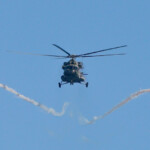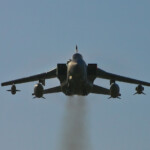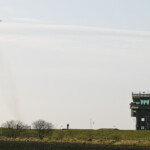Dambuster Heritage
This isn’t just any old accommodation, The Tower has an incredible history and RAF Wainfleet is in actual fact an old training ground for the legendary Dambusters. In more recent years before it ended it’s military use in 2010, F-15’s, A10’s and F1-11s were a common site here for target practice too.
In the 1970’s the original wooden structure was replaced with the existing tower and surrounding buildings that you still see standing here today. It was therefore essential to take great care when converting it to it’s current guise, to not to change it visually on the outside in order to retain it’s heritage and maintain it’s dignity as an RAF base.
A SHORT HISTORY OF ROYAL AIR FORCE WAINFLEET
The first record of weapons range at Wainfleet appears in 1890 when the marshes were used for Artillery. However, it is believed that cannon and musketry practice was carried out as far as Napoleonic times when the river Steeping was still navigable and Wainfleet was an important port.
In 1891 a set of Bye-Laws were published which defined the area of the range as:
“The foreshore and sands bounded by the Nottingham House Hotel in Freiston shore to the High Horn Buoy and on the north-east by a line drawn from the Wainfleet Groose Lane pull-over to the Wainfleet Buoy”.
Contravention of the Bye-Laws attracted a fine of £5 – a very considerable sum in those days!
the area was used for aircraft armament training from 1914 – 1918 initially by RNAS aircraft from HMS Deadulus (now RAF Cranwell) and from No 4 school of Aerial Fighting based at Freiston. There is evidence the the marshes were used for weapons training by both RAF and Royal Artillery during 1920 and 1930s. Recently an 18lb artillery shell dating from 1925 was ploughed up on reclaimed land close to Wainfleet – it was kept in a packing shed until someone discovered it was live !
RAF Wainfleet opened again as an aerial bombing and gunnery range in August 1938. A temporary accommodation site was constructed at Sea Lane Wainfleet which remained in constant use until the site was closed in 1991. During the 2nd WW, Wainfleet was used as a practice range by all types of aircraft engaged in the war effort.
Lancaster of 617 Sqn used the range to the test the famous “Bouncing Bomb”, and deep in the Wainfleet mud lie the shapes of the 22,000lb Tallboys used to penetrate the re-enforcement concrete pens protecting the German U Boats. Post war the area was used to dispose of bombs and ammunition of all types. At that times the marshes were of marginal value and there was little thought or control over the environment.the construction of the new sea bank in 1978 revealed the ordinance again when the farmers began ploughing the reclaimed land.
During the post war years the range has been used extensively by all types of military aircraft from Lincoln’s, Canberras and Vulcans to the Tornados and Harriers of the modern RAF. With the recent changes in the balance of power, range activity has decreased particularly with the withdrawal of the USAF A10 Tank-busters and F15s and Tornado aircraft in action on the range.
The range is staffed by 20 service and civilian personnel who control the aircraft and maintain the targets. 15 local civilians staff are employed by SERCO Ltd so the existence of the range also makes an important contribution to the local economy. There is a regular programme to ensure that the targets are kept clear of weapon debris to minimise risk to the public. The current range boundaries cover an area 55 square Kilometres and extend from the low water mark to the sea bank from Wainfleet sands to north-east and to Friskney flats in the south-west. The casual observer sees only the bleak and inhospitable area of coastline, but the sands and marshes are an ideal habitat for the flora and fauna which remain largely undisturbed by the general public.
The Wash marshes are of great importance to the nature conservation and the range area is designated a Site of Special Scientific Interest (SSSI). During the winter month thousands of Brent Geese arrive from their breeding grounds along the arctic coast to feed on Zoster weed which grows on the foreshore. Unfortunately they are also partial to winter wheat much to the dismay of local Farmers! On one occasion a snow goose was reported and also a snowy owl which brought an influx of “Twitchers” from all parts of the country.
Barn Owls and Marsh Harriers regularly patrol dykes in search of food and there has been frequents sightings of Merlin.
In summer there is a wide range of immigrant birds including such rarities as Black Redstarts and Isabelline Wheatears which in 1993 successfully reared their young in the area. A great variety of wading birds are always busy on the mudflats following the tides in and out.
Many other birds and animal species inhabit in this area such as Curlews, Plovers and Redshanks. Seals can be there in the summer months with their pups basking on the sand bars and creeks on the SW range. Flora includes many rare marsh plants as well as more common varieties such as sea Lavender and Samphire which is regarded as a culinary delicacy by some misguided people.
We hope with this history we have given you an insight of the history and work of RAF Wainfleet.
Hopefully you enjoy the countryside which it is now but please obey the the range warning signs. Remember, it has been an active range for over 100 years so if you do find anything suspicious please don’t take it home and put in on your mantelpiece.




